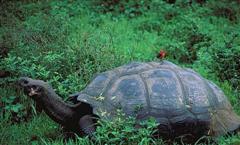Galapagos Tortoise
Scientific Name: Geochelone elephantopus
Sat, 26th April, 2025 - 10:47 am GMT
Sponsor Ads:

Alternative Name
Scientific Name: Geochelone elephantopusBasic Info
The Galapagos Tortoise can measure up to six feet from head to foot and weigh as much as 600 pounds. Female Galapagos Tortoises are generally a little bit smaller than their male counterparts, but they are no less impressive. This land giant moves at a speed of only 0.16 miles per hour, not surprising considering the "luggage" they are carrying around. Though the average lifespan of the Galapagos Tortoise is around 100 years, the oldest Giant Galapagos Tortoise on record was 152 years old. Some older individuals that have reached 200 years have also been reported, but this has not been verified. The longevity of this species is not surprising since it takes 40 to 50 years for the Tortoise to even reach adulthood!
Health
Breeding The Galapagos Tortoise will be ready to reproduce at 20 to 25 years of age. At this time, the mother will dig a deep nest and lay 2 to 16 eggs. She will then leave the eggs to incubate after reburying them. Four to eight months later, the eggs will hatch, and it may be another month before the hatchlings dig out of the nest.Habitat
N/ABehavior
The Galapagos Tortoise is one of the most impressive and is the largest of all tortoises. The Galapagos Tortoise is listed as an endangered species so they cannot be taken from the wild. The best way to contribute to the survival of this magnificent reptile would probably be to look into ways in which you can contribute to the Charles Darwin Foundation. This foundation has established a research center and rescue station where Galapagos Tortoise eggs are incubated and then the hatchlings are raised until about five years old when they can defend themselves against predators that man introduced to their natural habitat on the Galapagos Islands.Origin
GalapagosHistory
The Galapagos Tortoise sports the name of the islands it inhabits. The islands received their name when Spanish explorers came across the islands and saw the massive amount of tortoises roaming the islands. The word "Galapagos" means tortoise in Spanish, so it is easy to see how the relationship was established. Explorers were astounded by the massive size of these tortoises, and it didn't take them long to realize that they made a good source of meat. They also had the ability to survive long periods without food or water. This was definitely an unfortunate circumstance for the Galapagos Tortoise and as more humans visited the islands, they brought with them other animals, which often preyed upon eggs and young tortoises. The population of Galapagos Tortoises dropped from 250,000 to only 15,000 remaining today, with 3,500 of the remaining tortoises being introduced by centers such as the Charles Darwin Foundation. With continued support, the Galapagos Tortoise will hopefully see days of prosperity again.Common Foods
The Galapagos Tortoise is an herbivore, feeding primarily on bromeliads, water ferns, leaves, prickly pear cactus, fruits, and grasses.Sponsor Ads:
Making your mark on the world is hard. If it were easy, everybody would do it. But it's not. It takes patience, it takes commitment, and it comes with plenty of failure along the way. The real test is not whether you avoid this failure, because you won't. It's whether you let it harden or shame you into inaction, or whether you learn from it; whether you choose to persevere." -- President Barack Obama
Galapagos Tortoise
Coded by: BGID® | ALL RIGHTS RESERVED Copyright © 2000-2025
Disclaimer | Privacy | Report Errors / Contact | Credits








 President of the United States of America - Real Estate mogul, Pageant owner and now one of the most controversial men in political history.
President of the United States of America - Real Estate mogul, Pageant owner and now one of the most controversial men in political history.  Politician, US Vice President and President of the USA - Joseph Robinette Biden Jr.
Politician, US Vice President and President of the USA - Joseph Robinette Biden Jr.  versus
versus  Russia: 'The Evil Empire'? Are they all that bad or is it just the USA trying to portray Russia as bad because they are a world power with land bigger and a society very different from the USA ideal?
Russia: 'The Evil Empire'? Are they all that bad or is it just the USA trying to portray Russia as bad because they are a world power with land bigger and a society very different from the USA ideal?  Global warming has been in and out as the "latest" hot topic for many years. It is, according to modern scientists, the result of man-made industrial pollutants, clearing forested areas, agriculture, etc. But now they are thinking it started way before the Industrial Revolution...
Global warming has been in and out as the "latest" hot topic for many years. It is, according to modern scientists, the result of man-made industrial pollutants, clearing forested areas, agriculture, etc. But now they are thinking it started way before the Industrial Revolution... 
 Corona virus
Corona virus 
 Users with wide screen monitors can benefit from more content on every page.
Users with wide screen monitors can benefit from more content on every page.